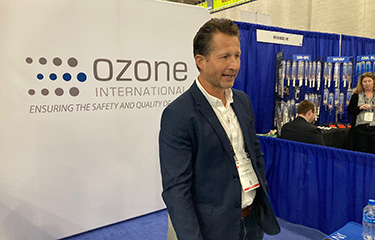Change of business model refreshed Ozone International’s seafood footprint

Fifty percent of Ozone International’s business is now with the seafood industry, thanks in part to a shift in the company’s business model.
The Bainbridge Island, Washington, U.S.A.-based company, which recently celebrated its 20th anniversary in business, was one of the pioneers of using ozone (O3) to sanitize food products and food-processing facilities after the U.S. Food and Drug Administration approved its use an antimicrobial agent for food in 2001.
Ozone International CEO Jon Brandt told SeafoodSource at the 2023 Seafood Expo North America in Boston, Massachusetts, U.S.A. that ozone treatment, which is used to fight bacteria growth and reduce odor in seafood processing, had its original heyday in the mid-2000s, when the technology first became widely available.
“People just learning about what the technology was, and there was a lot of adoption,” Brandt said. “But enough people tried it and it didn’t work for various reasons, and there were also a lot of skeptics and people who didn’t understand how it worked, that we eventually realized we had to change the experience.”
Ozone International had been selling ozone equipment, but then its users would have trouble with it, or it would break or get broken, according to Brandt.
“We realized they didn't want an ozone system, they wanted an outcome. They wanted longer shelf-life. They wanted odor-free facilities. They wanted to use less chemicals. So we got out of the device business and we got into the outcome business,” he said. “We did that by putting service trucks on the road and we started taking care of the machines for the customers. Before, when someone had a problem with on of our machines, we could be a plane flight and a week away from fixing it, or we would send parts and let them fix it on their own. Now we can be at 400 seafood facilities across North America simultaneously installing or performance maintenance on our machines.”
Brandt said the change has been a boon to the business.
“People didn’t see the results of ozone because they weren’t experts in it. You can’t just have the green [ozone] light on for it to work. You’ve got to make sure the sensors are calibrated, that the right amount is being applied, that it's completely safe for the workers. You’ve got to have accurate maintenance records. And many other things to run a reliable, effective, and safe program. Only by ensuring all those things did we change enough experiences where it actually changed the sentiment of the industry toward ozone.”
Still, Brandt said he’s careful not to overpromise when talking to potential clients.
“What we have to guard against right is overrepresenting how well it works. Twenty years ago, the buzz was that ozone was going to revolutionize the industry. No, it’s not. It's a good technology when used appropriately and not oversold. It's a great alternative or supplement for chemicals in food-safety programs. It's a great way to reduce waste in the seafood industry,” he said. “I've been doing this long enough that it's interesting to see an industry sentiment change toward seeing ozone for the solution that it is and not as a cure-all solution for seafood processors.”
Photo courtesy of Cliff White/SeafoodSource






Share